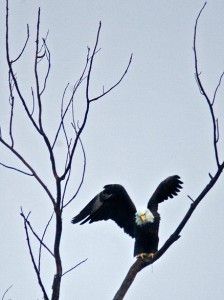Crab Orchard offers eagle-viewing tours

January 26, 2012
In 1964, there were fewer than 450 breeding pairs of bald eagles in the lower 48 United States.
Today, there are about 10,000.
Four of those pairs live in the Crab Orchard National Wildlife Refuge, five miles west of Marion. During the last two weekends in January, visitors can take guided tours to view eagle nests and spot other refuge-dwellers such as deer, red-tailed hawks and Canada geese.
Advertisement
Kim King-Wrenn, visitor services manager for the refuge, said the tours are very popular and fill up each year. She said more than 100 people show up each weekend to take the two-hour van tour into areas of the refuge usually restricted to visitors.
“People start making reservations in December. We have to turn a lot of people away,” she said.
The recent increase in the number of bald eagles in the United States is considered by naturalists to be an environmental success story.
When Europeans first arrived in North America, there may have been as many as half a million bald eagles.
Their numbers declined as the growing human population expanded westward because bald eagles and people competed for the same food: fish, waterfowl and small game.
Habitat destruction was also a factor in the decline of the bald eagle population in the lower 48 states. As America’s human population grew, forests were cut down to make room for farms, businesses and homes.
By the late 1800s, much of the eagles’ natural habitat was destroyed, leaving them with fewer places to nest and hunt.
Advertisement*
In response to the declining bald eagle population, Congress passed the Bald Eagle Protection Act in 1940, which made it illegal to hunt or harass both bald and golden eagles.
However, at about the same time, dichlorodiphenyltrichloroethane, or DDT, and other synthetic pesticides were becoming widely used by farmers in the United States.
Veronica Kelly, a senior from Grand Chain majoring in forestry, led a guided tour Saturday.
She said the DDT farmers sprayed on their crops ended up in streams and rivers, where it was absorbed by fish.
Bald eagles became exposed to DDT when they ate contaminated fish. The bioaccumulation of DDT in mother eagles caused their eggs to be formed with very thin shells that cracked before the chicks were fully developed. As a result, eagles were raising fewer young so their population continued to decline, she said.
Congress responded by passing the Endangered Species Act in 1973. According to the U.S. Fish and Wildlife Service website, this landmark legislation is regarded as one of the most important and comprehensive laws enacted to protect wildlife.
The same year, the U.S. Environmental Protection Agency banned the use of DDT.
“As a result, in 1993, the bald eagle population in the United States skyrocketed, and in 2007 they came off the endangered species list,” Kelly said.
Vicki Lang, an Anna resident who has volunteered at the refuge for fifteen years, was also a tour leader. She said the No. 1 mission of the refuge is protecting wildlife habitat for all inhabitants, including the bald eagle.
She pointed out an eagle nest, or aerie, situated in the crotch of a tall tree.
“This nest is the oldest nest on the refuge. It’s been used for almost 30 years,” she said. “Eagles use the same nest year after year. Each year they do some housekeeping on it.”
Lang said bald eagles refurbish their nests during January and February. The nests are typically five feet across, but can expand to as much as eight feet because eagles will continue to add sticks and mud each year.
Bald eagles mate for life, and both the male and female help raise their young. In southern Illinois, the female lays two or three eggs in March or April. The parents take turns incubating the eggs for 35 days, she said.
Lang said after the eggs hatch, both parents feed them for about three months.
She said bald eagles prefer fish, but during the winter months they eat ducks and geese because fish stay too far below the surface for eagles to catch.
This year, waterfowl that normally migrate to southern Illinois during the winter are staying farther north because of warmer-than-average temperatures.
“This winter, the eagles have to fly farther to find waterfowl to eat,” she said.
Diane Reader, a Murphysboro resident, said she was impressed with the tour and enjoyed seeing the refuge. She said she spent time eagle-watching in Alaska several years ago, where eagles had not suffered the same decline in population.
“They seemed like they were everywhere in Alaska. They are a common sight there,” she said.
Advertisement







